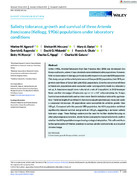| dc.contributor.author | Ngarari, Morine M. | |
| dc.contributor.author | Rugendo, Derrick G. | |
| dc.contributor.author | Nyonje, Betty M. | |
| dc.contributor.author | Hinzano, Sheban M. | |
| dc.contributor.author | Midumbi, David O. | |
| dc.contributor.author | Ngugi, Charles C. | |
| dc.contributor.author | Opiyo, Mary A. | |
| dc.contributor.author | Okalo, Francis A. | |
| dc.contributor.author | Gatune, Charles W. | |
| dc.date.accessioned | 2024-04-19T06:02:08Z | |
| dc.date.available | 2024-04-19T06:02:08Z | |
| dc.date.issued | 2024-04-17 | |
| dc.identifier.citation | Aquaculture, Fish and Fisheries Volume4, Issue2 | en_US |
| dc.identifier.uri | https://doi.org/10.1002/aff2.166 | |
| dc.identifier.uri | https://karuspace.karu.ac.ke/handle/20.500.12092/3081 | |
| dc.description | Main text | en_US |
| dc.description.abstract | In the 1980s, Artemia franciscana from San Francisco Bay (SFB) was introduced into Kenyan saltworks, where it has colonized and established stable populations. However, little is known about its biology, particularly with respect to its parental SFB population. This study compared the salinity tolerances of Kenyan (KEN) population, their SFB pro-genitors and those of Great Salt Lake (GSL) populations. Growth and survival of these A. franciscana populations were evaluated under varying salinity levels in a laboratory set up. A. franciscana nauplii were cultured at a rate of 1 nauplii/mL in 36 Erlenmeyer flasks and fed microalgae (Chaetoceros sp.) at 1.5 × 106 cells/animal/day for 8 days. Survival was evaluated daily and survivors were fixed in individual vials with Lugol solution. The total length of each fixed A. franciscana nauplii specimen was measured under a compound microscope. All populations were susceptible to salinities greater than 100 g/L. Compared with the parental SFB population, the KEN population exhibited significantly reduced survival and growth at 140 g/L, suggesting a narrower salinity tolerance range. These findings underscore the need for further studies focusing on other physiological parameters, abiotic factors and genetic characterization to confirm whether the KEN population is experiencing ecological adaptation. This will contribute to the optimization of Artemia practices in various salinity environments as a result of climate change. | en_US |
| dc.language.iso | en | en_US |
| dc.publisher | Wiley | en_US |
| dc.subject | A. franciscana | en_US |
| dc.subject | growth | en_US |
| dc.subject | Kenya | en_US |
| dc.subject | salinity | en_US |
| dc.subject | survival | en_US |
| dc.title | Salinity tolerance, growth and survival of three Artemia franciscana (Kellogg, 1906) populations under laboratory conditions | en_US |
| dc.type | Article | en_US |
